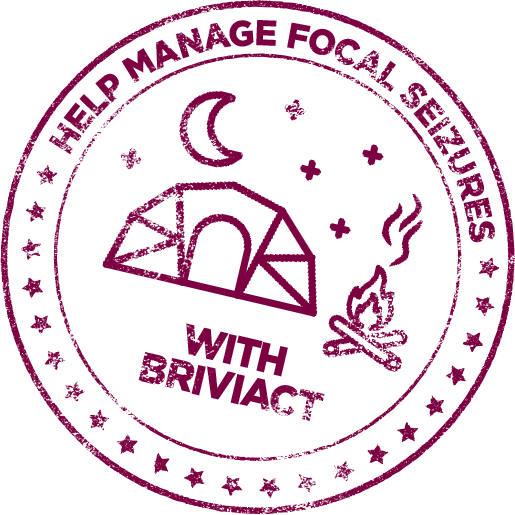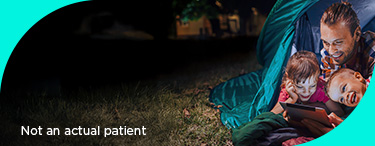What is BRIVIACT?
BRIVIACT® (brivaracetam) CV is a prescription medicine used to treat partial-onset seizures in people 1 month of age and older. It is not known if BRIVIACT is safe and effective in children younger than 1 month of age.
What is the most important information I should know about BRIVIACT?
BRIVIACT is a federally controlled substance (CV) because it can be abused or lead to dependence. Keep BRIVIACT in a safe place to prevent misuse and abuse. Selling or giving away BRIVIACT may harm others and is against the law.
Like other antiepileptic drugs, BRIVIACT may cause suicidal thoughts or actions in a very small number of people, about 1 in 500 people taking it.
Call a healthcare provider right away if you have any of these symptoms, especially if they are new, worse, or worry you:
- thoughts about suicide or dying
- attempts to commit suicide
- new or worse depression
- new or worse anxiety
- feeling agitated or restless
- panic attacks
- trouble sleeping (insomnia)
- new or worse irritability
- acting aggressive, feeling angry, or being violent
- acting on dangerous impulses
- an extreme increase in activity and talking (mania)
- other unusual changes in behavior or mood
Do not stop BRIVIACT without first talking to a healthcare provider.
- Stopping BRIVIACT suddenly can cause serious problems.
- Stopping a seizure medicine suddenly can cause seizures that will not stop (status epilepticus).
Who should not take BRIVIACT?
Do not take BRIVIACT if you are allergic to brivaracetam or any of the ingredients in BRIVIACT.
What should I tell my healthcare provider before starting BRIVIACT?
Before taking BRIVIACT, tell your healthcare provider about all of your medical conditions, including if you:
- have or had depression, mood problems, or suicidal thoughts or behavior.
- have liver problems.
- have abused or been dependent on prescription medicines, street drugs, or alcohol.
- are pregnant or plan to become pregnant. It is not known if BRIVIACT will harm your unborn baby.
- are breastfeeding or plan to breastfeed. BRIVIACT passes into your breast milk.
What should I avoid while taking BRIVIACT?
Do not drive or operate machinery until you know how BRIVIACT affects you. BRIVIACT may cause drowsiness, tiredness, dizziness, and problems with your balance and coordination.
What are the possible side effects of BRIVIACT?
BRIVIACT may cause serious side effects, including:
- See “What is the most important information I should know about BRIVIACT?”
- Nervous system problems. Drowsiness, tiredness, and dizziness are common with BRIVIACT, but can be severe. See “What should I avoid while taking BRIVIACT?” BRIVIACT can also cause problems with balance and coordination.
- Mental (psychiatric) symptoms. BRIVIACT can cause mood and behavior changes such as aggression, agitation, anger, anxiety, apathy, mood swings, depression, hostility, and irritability. Irritability and anxiety are common with BRIVIACT, and can be severe. People who take BRIVIACT can also get psychotic symptoms such as hallucinations (seeing or hearing things that are really not there), delusions (false or strange thoughts or beliefs), and unusual behavior.
- Serious allergic reactions. Stop taking BRIVIACT and call your healthcare provider right away if you have any of these signs of a serious allergic reaction: swelling of your face, mouth, lips, gums, tongue, throat, or neck, or trouble breathing.
- Serious skin rashes. BRIVIACT may cause a severe rash with blisters and peeling skin. This may occur around the mouth, nose, eyes, and genitals or over much of the body. A mild rash may become a serious reaction and may cause death. Call your healthcare provider right away if you have a rash, skin blisters, sores in the mouth, or hives. Do not stop taking BRIVIACT without first talking to your healthcare provider.
The most common side effects of BRIVIACT in adults include:
- sleepiness
- dizziness
- feeling tired
- nausea and vomiting
Side effects of BRIVIACT in children 1 month to less than 16 years of age are similar to those seen in adults.
These are not all the possible side effects of BRIVIACT. For more information, ask your healthcare provider or pharmacist. Tell your healthcare provider about any side effect that bothers you or that does not go away. Call your doctor for medical advice about side effects. You are encouraged to report negative side effects of prescription drugs to the FDA. Visit www.fda.gov/medwatch or call 1-800-FDA-1088. You may also report side effects to UCB, Inc. at UCBCares 844-599-CARES (2273).



